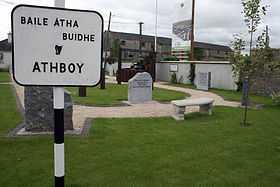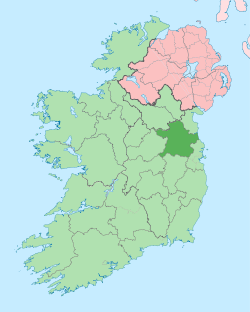Athboy
| Athboy Baile Átha Buí | |
|---|---|
| Town | |
 Athboy Location in Ireland | |
| Coordinates: 53°37′00″N 6°55′00″W / 53.616667°N 6.916667°WCoordinates: 53°37′00″N 6°55′00″W / 53.616667°N 6.916667°W | |
| Country | Ireland |
| Province | Leinster |
| County | County Meath |
| Elevation | 61 m (200 ft) |
| Population (2011) | |
| • Urban | 2,397 |
| Time zone | WET (UTC+0) |
| • Summer (DST) | IST (WEST) (UTC-1) |
| Irish Grid Reference | N800567 |
| Historical population | ||
|---|---|---|
| Year | Pop. | ±% |
| 1821 | 1,569 | — |
| 1831 | 1,959 | +24.9% |
| 1841 | 1,826 | −6.8% |
| 1851 | 1,204 | −34.1% |
| 1861 | 982 | −18.4% |
| 1871 | 861 | −12.3% |
| 1881 | 748 | −13.1% |
| 1891 | 633 | −15.4% |
| 1901 | 610 | −3.6% |
| 1911 | 575 | −5.7% |
| 1926 | 510 | −11.3% |
| 1936 | 520 | +2.0% |
| 1946 | 402 | −22.7% |
| 1951 | 418 | +4.0% |
| 1956 | 717 | +71.5% |
| 1961 | 680 | −5.2% |
| 1966 | 678 | −0.3% |
| 1971 | 705 | +4.0% |
| 1981 | 909 | +28.9% |
| 1986 | 1,055 | +16.1% |
| 1991 | 1,083 | +2.7% |
| 1996 | 1,172 | +8.2% |
| 2002 | 1,538 | +31.2% |
| 2006 | 2,213 | +43.9% |
| 2011 | 2,397 | +8.3% |
| [1][2][3][4][5] | ||
Athboy (Irish: Baile Átha Buí, meaning "Town of the Yellow Ford"), is a small agricultural town in County Meath in Ireland. It is located on the junction of the N51 and R154 roads. The town is located on the Yellow Ford River, in wooded country near the County Westmeath border.
History


In medieval times it was a walled stronghold of the Pale. Eoin Roe O'Neill took it in 1643, and six years later Oliver Cromwell camped his army on the Hill of Ward nearby. Also known as Tlachtga, the Hill of Ward was the location for the pagan feast of Samhain, the precursor of modern day Halloween.
The tower of St James, Church of Ireland is a remnant of a 14th-century Carmelite priory. Behind the church are the remains of the town walls. The church boasts an interesting medieval table top.[6]
In 1694, the town's 'lands and commons' and several other denominations of land were erected into a manor and granted to Thomas Bligh, MP for Athboy, who had earlier purchased almost 12 km² (3000 acres) in the area of Athboy. His son, John, was created "Earl of Darnley" in 1725 and the Blighs (Earls of Darnley) were landlords of all but six of the 27 townlands in the parish of Athboy throughout the 18th and 19th centuries.
Ivo Bligh, 8th Earl of Darnley placed the fee-simple of the town of Athboy up for public auction in June 1909. The townspeople formed their own branch of The Town Tenants League and with the aid of Joseph Coghlan-Briscoe, national secretary of the league, they were able to purchase their homes and businesses via private treaty.[7] The demesne of the Darnley Estate at Clifton Lodge just outside the town was sold in 1909 to Welsh explorer Mordecai Jones. Not long after Jones' death in 1913 his Japanese manservant Sanotic Koniste was found murdered in a field not far from Clifton Lodge.[8] Both Jones and Koniste are buried in the graveyard of St. James' Church.
People
- Frederick Harvey, recipient of the Victoria Cross
- Fr. Eugene O'Growney, key figure in the Gaelic Revival
Transport
Railway
Athboy railway station opened on 26 February 1864, but was closed to passenger traffic on 27 January 1947 and finally closed on 1 September 1954.[9]
Bus
Today the town has regular bus services to Trim, Dublin, Granard and Cavan which are provided as Bus Éireann route 111 though passengers to/from Granard and Cavan must change bus at Athboy.[10] In November 2013 a new Bus Éireann route, 190A, was introduced providing several journeys each way daily to Navan, Slane, Drogheda and Laytown.[11] During college terms there is a Sundays-only route 070 coach to Athlone, Navan and Dundalk.[12]
Education
As well as rural primary schools in Rathmore and Rathcairn, O' Growney National School had provided education for the Athboy population since 1949.[13]
In terms of secondary education, the former St. Joseph's Convent of Mercy amalgamated with Athboy Vocational School in 2004 to form Athboy Community School.[14] The school is currently located on the site behind the vocational school where they moved to in 2011. O'Growney are now preparing to build a new school which be built by the end of 2015
Popular Culture
On 4 May 2011, Athboy featured on RTÉ's Dirty Old Towns programme, in which the local community came together to convert an old piggery into a thriving Farmers' Market.
Every June Bank Holiday, the County Meath Macra na Feirme clubs host the "Blue Jean Country Queen Festival", in which the "Queens" representing Macra clubs from all over Ireland and abroad come to the town for a fun-filled weekend before one is crowned the winner. The Festival was created in 1987 by Patrick Farrelly from Carnaross Macra after hearing the song "I'm A Blue Jean Country Queen". 2012 was the 25th year of the Festival as the Foot and Mouth Disease forced most Festivals to be cancelled in 2001. The Festival is music based which incorporates community development with free family fun while promoting local tourism and attractions nationally as well as internationally.[15]
See also
- List of populated places in Ireland
References
- ↑ Census for post 1821 figures.
- ↑ http://www.histpop.org
- ↑ http://www.nisranew.nisra.gov.uk/census
- ↑ Lee, JJ (1981). "On the accuracy of the Pre-famine Irish censuses". In Goldstrom, J. M.; Clarkson, L. A. Irish Population, Economy, and Society: Essays in Honour of the Late K. H. Connell. Oxford, England: Clarendon Press.
- ↑ Mokyr, Joel; O Grada, Cormac (November 1984). "New Developments in Irish Population History, 1700-1850". The Economic History Review. Volume 37 (4): 473–488. doi:10.1111/j.1468-0289.1984.tb00344.x.
- ↑ Meath Heritage information brochure
- ↑ Brogan, Patrick, 'A Thriving and Historic Town' in Athboy Anois Vol.2 (December 2014)
- ↑ Gilroy, John, A Cry In The Morning: The Global Search for Sanotic Koniste (Pikefield Publications 2013)
- ↑ "Athboy station" (PDF). Railscot - Irish Railways. Archived (PDF) from the original on 26 September 2007. Retrieved 2007-09-08.
- ↑ http://www.buseireann.ie/pdf/1307702393-111.pdf
- ↑ http://buseireann.ie/news.php?id=1394&month=Nov
- ↑ http://www.buseireann.ie/pdf/1360753126-070.pdf
- ↑ "O' Growney NS, Athboy". O' Growney NS, Athboy. Retrieved 2011-05-13.
- ↑ "Athboy CS". Athboy CS. Retrieved 2011-05-13.
- ↑ "Blue Jean Festival Website". Retrieved 9 June 2012.
Sources
- Noel E. French, A short history of Rathmore and Athboy (1995)
- Beryl F.E. Moore, "Tombs in Athboy Graveyard", Irish Ancestor, volume 13 (1981), pp. 123–4
External links
| Wikimedia Commons has media related to Athboy. |
